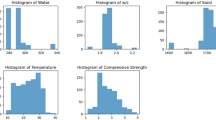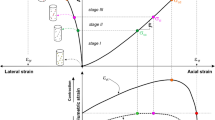Abstract
Rockburst is a common dynamic phenomenon due to high stress in deep underground spaces, which has many destructive effects based on the intensity of occurrence. Therefore, by predicting the risk of this phenomenon and using the necessary measures, the destructive effects of this phenomenon can be reduced. In this paper, a semi-quantitative risk matrix model has been developed for assessing rockburst risk. For quantitatively determining the probability and consequence of the rockburst, as two main components of the risk matrix, two models were developed using the logistic model tree (LMT) method. These models were developed based on a database containing the most effective parameters on the occurrence of rockburst. After developing the models, their accuracy was evaluated by performance criteria including accuracy (AC), specificity (SP), sensitivity (SE), Matthew’s correlation coefficient (MCC), and receiver operating characteristic curve. The results showed that the two developed models have high performances (for the probability model, the values of AC, SE, SP, and MCC are 0.96, 0.79, 0.99, and 0.85, respectively, and for the consequence model the results are 0.93, 0.82, 0.95, and 0.81, respectively) and also comparing two developed models with previous models revealed that both models have acceptable accuracy. Finally, based on the developed models, a semi-quantitative framework was provided to evaluate the risk of rockburst using risk matrix. This framework can be applied to reduce the casualties resulting from rockburst in underground spaces during design and construction phases.








Similar content being viewed by others
References
Abedini M, Ghasemian B, Shirzadi A, Bui DT (2019) A comparative study of support vector machine and logistic model tree classifiers for shallow landslide susceptibility modeling. Environ Earth Sci 78:1–15
Adoko AC, Gokceoglu C, Wu L, Zuo QJ (2013) Knowledge-based and data-driven fuzzy modeling for rockburst prediction. Int J Rock Mech Min Sci 61:86–95. https://doi.org/10.1016/j.ijrmms.2013.02.010
Adoko A, Zvarivadza T (2018) A bayesian approach for predicting rockburst. In: 52nd US rock mechanics/geomechanics symposium. American Rock Mechanics Association
Afraei S, Shahriar K, Madani SH (2018) Statistical assessment of rock burst potential and contributions of considered predictor variables in the task. Tunn Undergr Space Technol 72:250–271. https://doi.org/10.1016/j.tust.2017.10.009
Afraei S, Shahriar K, Madani SH (2019) Developing intelligent classification models for rock burst prediction after recognizing significant predictor variables, section 2: designing classifiers. Tunn Undergr Space Technol 84:522–537. https://doi.org/10.1016/j.tust.2018.11.011
Blake W, Hedley DGF (2003) Rockbursts: case studies from North American hard-rock mines. SME, Littleton
Bouckaert RR, Frank E, Hall M, Kirkby R, Reutemann P, Seewald A, Scuse D (2016) WEKA manual for version 3-9-1. The University of Waikato, Hamilton
Buckle F (1965) The rock-burst hazard in Wright-Hargreaves mine at Kirkland Lake, Ontario. Can Min J 86:81–87
Bui DT, Tuan TA, Klempe H, Pradhan B, Revhaug IJL (2016) Spatial prediction models for shallow landslide hazards: a comparative assessment of the efficacy of support vector machines, artificial neural networks, kernel logistic regression, and logistic model tree. Landslides 13:361–378
Bui DT, Shahabi H, Shirzadi A, Chapi K, Pradhan B, Chen W, Khosravi K, Panahi M, Bin Ahmad B, Saro L (2018) Land subsidence susceptibility mapping in south korea using machine learning algorithms. Sensors 18:2464
Bui X-N, Nguyen H, Choi Y, Nguyen-Thoi T, Zhou J, Dou J (2020) Prediction of slope failure in open-pit mines using a novel hybrid artificial intelligence model based on decision tree and evolution algorithm. Sci Rep 10:1–17
Chapi K, Singh VP, Shirzadi A, Shahabi H, Bui DT, Pham BT, Khosravi K (2017) A novel hybrid artificial intelligence approach for flood susceptibility assessment. Environ Model Softw 95:229–245
Chen HJ, Li NH, Ni DX, Shang YQ (2003) Prediction of rockburst by artificial neural network. Chin J Rock Mech Eng 22:762–768
Dietz M, Oremek GM, Groneberg DA, Bendels MHK (2018) What is a rock burst? Zentralblatt Für Arbeitsmedizin Arbeitsschutz Und Ergonomie 68:45–49. https://doi.org/10.1007/s40664-017-0215-z
Dong L-j, Li X-b, Peng K (2013) Prediction of rockburst classification using Random Forest. Trans Nonferrous Met Soci China 23:472–477. https://doi.org/10.1016/S1003-6326(13)62487-5
Faradonbeh RS, Taheri A (2019) Long-term prediction of rockburst hazard in deep underground openings using three robust data mining techniques. Eng Comput 35:659–675
Feng X-T (2018) Chapter 13—avoiding high-stress concentrations by reasonable excavation methods. In: Feng X-T (ed) Rockburst. Butterworth-Heinemann, Oxford, pp 441–451
Feng X-T, Wang L (1994) Rockburst prediction based on neural networks. Trans Nonferrous Met Soc China 4:7–14
Ge Q, Feng X (2008) Classification and prediction of rockburst using AdaBoost combination learning method. Rock Soil Mech 29:943–948
Ghasemi E, Gholizadeh H (2019a) Development of two empirical correlations for tunnel squeezing prediction using binary logistic regression and linear discriminant analysis. Geotech Geol Eng 37:3435–3446
Ghasemi E, Gholizadeh H (2019b) Prediction of squeezing potential in tunneling projects using data mining-based techniques. Geotech Geol Eng 37:1523–1532
Ghasemi E, Sari M, Ataei M (2012) Development of an empirical model for predicting the effects of controllaable blasting parameters on flyrock distance in surface mines. Int J Rock Mech Min Sci 52:163–170
Ghasemi E, Gholizadeh H, Adoko AC (2020) Evaluation of rockburst occurrence and intensity in underground structures using decision tree approach. Eng Comput 36:213–225
Gibowicz SJ (2009) Chapter 1—seismicity induced by mining: recent research. In: Dmowska R (ed) Advances in geophysics. Elsevier, Amsterdam, pp 1–53
Han J, Pei J, Kamber M (2011) Data mining: concepts and techniques. Elsevier, Amsterdam
Jianxing Y, Haicheng C, Shibo W, Haizhao F (2021) A novel risk matrix approach based on cloud model for risk assessment under uncertainty. IEEE Access 9:27884–27896
Jones G (2019) Risk management strategy. Essex County Council, Essex
Kaiser PK (2018) Excavation vulnerability and selection of effective rock support to mitigate rockburst damage. In: Feng XT (ed) Rockburst. Elsevier, Amsterdam, pp 473–518
Karwoski WJ, McLaughlin WC, Blake W (1979) Rock preconditioning to prevent rock bursts: report on a field demonstration. Department of the Interior, Bureau of Mines, Washington, DC
Ke B, Khandelwal M, Asteris PG, Skentou AD, Mamou A, Armaghani DJ (2021) Rock-burst occurrence prediction based on optimized Naïve Bayes models. IEEE Access 9:91347–91360
Kidybiński A (1981) Bursting liability indices of coal. Int J Rock Mech Min Sci Geomech Abstr 18:295–304. https://doi.org/10.1016/0148-9062(81)91194-3
Koldas KS (2003) Rockburst and fall of ground investigations in deep level gold mines: South African example. In: lst international mining congress and exhibition of Turkey-IMCET 2003, Ankara, Turkey, pp 237–244
Konicek P (2018) Chapter 14—destressing. In: Feng X-T (ed) Rockburst. Butterworth-Heinemann, Oxford, pp 453–471
Landwehr N, Hall M, Frank E (2005) Logistic model trees. Mach Learn 59:161–205
Li N, Jimenez R (2018) A logistic regression classifier for long-term probabilistic prediction of rock burst hazard. Nat Hazards 90:197–215. https://doi.org/10.1007/s11069-017-3044-7
Li N, Feng X, Jimenez R (2017) Predicting rock burst hazard with incomplete data using Bayesian networks. Tunn Undergr Space Technol 61:61–70. https://doi.org/10.1016/j.tust.2016.09.010
Li N, Yi C (2020) Predicting underground rock pillar stability using logistic model tree method. In: ISRM international symposium-EUROCK 2020-153
Liu Z, Shao J, Xu W, Meng Y (2013) Prediction of rock burst classification using the technique of cloud models with attribution weight. Nat Hazards 68:549–568. https://doi.org/10.1007/s11069-013-0635-9
Markowski AS, Mannan MS (2008) Fuzzy risk matrix. J Hazard Mater 159:152–157. https://doi.org/10.1016/j.jhazmat.2008.03.055
Nhu V-H, Shirzadi A, Shahabi H, Singh SK, Al-Ansari N, Clague JJ, Jaafari A, Chen W, Miraki S, Dou J (2020) Shallow landslide susceptibility mapping: a comparison between logistic model tree, logistic regression, Naïve Bayes tree, artificial neural network, and support vector machine algorithms. Int J Environ Res Public Health 17:2749
Özfirat MK, Özkan E, Kahraman B, Şengün B, Yetkin ME (2017) Integration of risk matrix and event tree analysis: a natural stone plant case. Sādhanā 42:1741–1749. https://doi.org/10.1007/s12046-017-0725-6
Pu Y, Apel DB, Lingga B (2018) Rockburst prediction in kimberlite using decision tree with incomplete data. J Sustain Min 17:158–165. https://doi.org/10.1016/j.jsm.2018.07.004
Pu Y, Apel DB, Xu H (2019) Rockburst prediction in kimberlite with unsupervised learning method and support vector classifier. Tunn Undergr Space Technol 90:12–18. https://doi.org/10.1016/j.tust.2019.04.019
Sari M, Ghasemi E, Ataei M (2014) Stochastic modeling approach for the evaluation of backbreak due to blasting operations in open pit mines. Rock Mech Rock Eng 47:771–783
Shukla R, Khandelwal M, Kankar P (2021) Prediction and assessment of rock burst using various meta-heuristic approaches. Min Metall Explor 38:1–7
Singh T, Kanchan R, Verma A, Saigal K (2005) A comparative study of ANN and neuro-fuzzy for the prediction of dynamic constant of rockmass. J Earth Syst Sci 114:75–86
Smith J (1998) Project risk management: processes, techniques and insights. J Oper Res Soc 49:769–770
Tang CA, Hudson JA (2010) Rock failure mechanisms: explained and illustrated. CRC, Boca Raton
Tomory A, Carvalho J, Kowalczyk M , Tomory B (2014) Logistic regression in hard rock pillar design. In: 48th US rock mechanics/geomechanics symposium, Minneapolis, Minnesota, June 2014. Paper number: ARMA-2014-7044
Verma AK, Singh TN (2011) Intelligent systems for ground vibration measurement: a comparative study. Eng Comput 27:225–233
Verma AK, Singh TN (2013) Comparative study of cognitive systems for ground vibration measurements. Neural Comput Appl 22:341–350
Wei C, Zhang C, Canbulat I, Cao A, Dou L (2018) Evaluation of current coal burst control techniques and development of a coal burst management framework. Tunn Undergr Space Technol 81:129–143. https://doi.org/10.1016/j.tust.2018.07.008
Whyatt J, Blake W, Williams T , White B (2002) 60 years of rockbursting in the Coeurd'Alene District of Northern Idaho, USA: lessons learned and remaining issues
Xu C, Liu X, Wang E, Zheng Y, Wang S (2018) Rockburst prediction and classification based on the ideal-point method of information theory. Tunn Undergr Space Technol 81:382–390. https://doi.org/10.1016/j.tust.2018.07.014
Xue Y, Bai C, Qiu D, Kong F, Li Z (2020) Predicting rockburst with database using particle swarm optimization and extreme learning machine. Tunn Undergr Space Technol 98:103287. https://doi.org/10.1016/j.tust.2020.103287
Zhang C, Feng X-T, Zhou H, Qiu S, Wu W (2012) Case histories of four extremely intense rockbursts in deep tunnels. Rock Mech Rock Eng 45:275–288. https://doi.org/10.1007/s00603-011-0218-6
Zhao HB (2005) Classification of rockburst using support vector machine. Rock Soil Mech 26:642–644
Zhou J, Li X, Shi X (2012) Long-term prediction model of rockburst in underground openings using heuristic algorithms and support vector machines. Saf Sci 50:629–644. https://doi.org/10.1016/j.ssci.2011.08.065
Zhou J, Li X, Mitri HS (2016a) Classification of rockburst in underground projects: comparison of ten supervised learning methods. J Comput Civ Eng 30:04016003
Zhou J, Shi X-z, Huang R-d, Qiu X-y, Chen C (2016b) Feasibility of stochastic gradient boosting approach for predicting rockburst damage in burst-prone mines. Trans Nonferrous Met Soc China 26:1938–1945. https://doi.org/10.1016/S1003-6326(16)64312-1
Zhou K-p, Lin Y, Deng H-w, Li J-l, Liu C-j (2016c) Prediction of rock burst classification using cloud model with entropy weight. Trans Nonferrous Met Soc China 26:1995–2002. https://doi.org/10.1016/S1003-6326(16)64313-3
Zhou J, Li X, Mitri H (2018) Evaluation method of rockburst: state-of-the-art literature review. Tunn Undergr Space Technol 81:632–659
Zhou J, Guo H, Koopialipoor M, Armaghani DJ, Tahir M (2020) Investigating the effective parameters on the risk levels of rockburst phenomena by developing a hybrid heuristic algorithm. Eng Comput 37:1–16
Zweig MH, Campbell G (1993) Receiver-operating characteristic (ROC) plots: a fundamental evaluation tool in clinical medicine. Clin Chem 39:561–577
Funding
The authors have not disclosed any funding.
Author information
Authors and Affiliations
Corresponding author
Ethics declarations
Conflict of interest
The authors declare that they have no known competing fnancial interests or personal relationships that could have appeared to infuence the work reported in this paper.
Additional information
Publisher's Note
Springer Nature remains neutral with regard to jurisdictional claims in published maps and institutional affiliations.
Supplementary Information
Below is the link to the electronic supplementary material.
Rights and permissions
About this article
Cite this article
Kadkhodaei, M.H., Ghasemi, E. Development of a Semi-quantitative Framework to Assess Rockburst Risk Using Risk Matrix and Logistic Model Tree. Geotech Geol Eng 40, 3669–3685 (2022). https://doi.org/10.1007/s10706-022-02122-9
Received:
Accepted:
Published:
Issue Date:
DOI: https://doi.org/10.1007/s10706-022-02122-9




